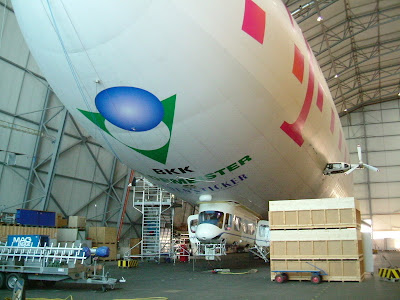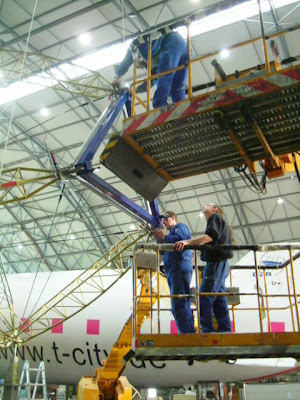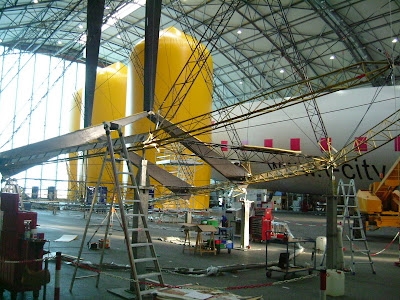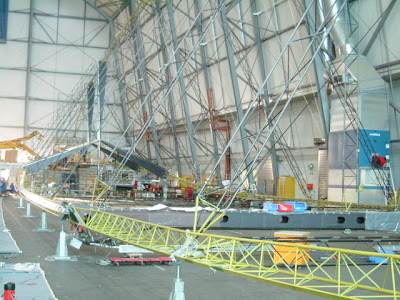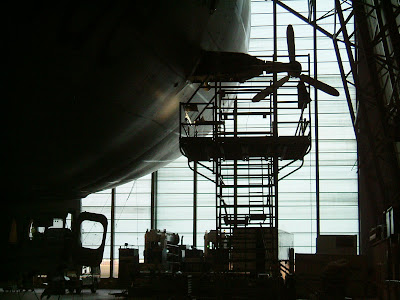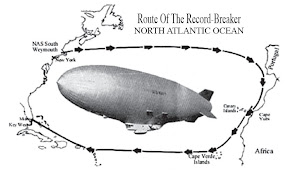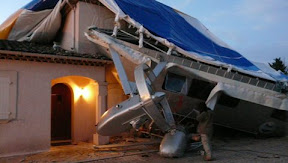
We just got word that the
Total Pole Airship got destroyed as it broke loose of it's mooring mast this night. This information is not confirmed yet, we will update this post on the Blog as more information comes in. This is what we go so far.
Thomas Goodey from the
Flying Kettle Project send an Email to the Colorado Airship-list quoting from another Email list:
French Original:
Cette nuit, le dirigeable de Jean Louis Etienne a rompu ses amarres pour aller s'ecraser sur une maison pres de Fayence...
English Translation:
That night, the airship Jean Louis Etienne broke its moorings to go crash on a house near Fayence ...
Please send email to
airshipworld at gmail.com if you have any more detail about the incident.
[Update 1]This is the original mail sent by Thierry Garcon to the
Objectif Dirigeable MailinglistBien triste nouvelle !
Cette nuit, le dirigeable de Jean Louis Etienne a rompu ses amarres pour aller s’écraser sur une maison près de Fayence
Thierry
[Update 2]The
Total Pole Website just got updated
here is the original french site, and
here the english translation.
[Update 3]Thomas Goodey provied us with a better english translation of the article from the Total Pole Airship Website
The dirigible of Jean-Louis Etienne taken by the winds
The dirigible of the explorer Jean-Louis Etienne, with which he was
to make his expedition in the Arctic, destroyed itself Tuesday
morning, at 6:26 on 22 January.
Mathieu Gauche, ground team member, was on watch when the dirigible
was lifted from its mast to the vertical by winds of 55 nSuds (I
suppose they mean "knots") (100 km/hour). The posts of 4 cm diameter
and 1 meter 60 depth, which held the mast, were all torn out.
Thus the dirigible had started its trajectory on the aerodrome when
the rest of the team of the Total Pole Airship expedition arrived on
site. They threw themselves into the search for the dirigible with
the aid of car headlights. The dirigible then rose to 30 meters above
the ground, and crossed the D562 road. The mast hit a hangar, and
finished beaten down by a gust on a neighboring house. (I suppose
they mean, the airship did that.)
Stephane Luchini, expedition pilot, checked the weather forecast the
night before at 22:00; no storm was forecast.
Jean-Louis Etienne will discuss the matter today during a press
conference which will take place at 15:30 at Fayence aerodrome.
We are looking forward to further details, but it's a sad day for the airship community our thoughts are with Jean-Louis and his team.
[Update 4]Thomas Goodey keeps us updated on what he can find out via the
Objectif Dirigeable Mailinglist. Here is what he heard so far
And another posting on the list says:
> A les degats, je pense qu'il y a peu d'espoir de voir revoler
> cet engin.
which means "From the damage, I think that there is little hope of
seeing this craft fly again."
And another posting says:
> Bien triste nouvelle effectivement, le ballon a subit une meteo
> extreme ce matin, des vents de plus de 120 km/h tourbillonnants ont
> eu raison de l´encrage du mat.
"Certainly very sad news; the balloon suffered extreme weather this
morning - turbulent winds of more than 120 km/h were the cause of the
mast being torn out."
> En effet le ballon est parti avec son mat, a traverse le terrain de
> Fayence deracine un arbre de 10m et s´est arrete autour d´une maison.
"And the balloon left the scene with its mast, crossed the Fayence
grounds, tore up a 10m tree by the roots, and stopped around a
house."
> L´enveloppe est dechiquetee, la nacelle et les gouvernes ne semblent
> pas completements detruites.
"The envelope is mutilated; the nacelle and the fins do not seem to
be completely destroyed."
> J´espere que le demontage a les cisailles n´auront pas raison de ce
> qui a survecu
"I hope that the dismantling with shears..." I can't construe the
meaning of the rest of this sentence.
[Update 5]Bloomberg picked up the story, and has a little report on it
here.
[Update 6]Reuters now has a story on the accident. Here are the most noteable bits, for the
full story click here:
French explorer Jean-Louis Etienne had planned to depart on March 1 from Paris on a 10,000-kilometer (6,200 mile) voyage that was expected to provide a benchmark for monitoring the impact of global warming on the Polar Basin.
"The expedition is cancelled with this airship," a spokeswoman said.
"But Jean-Louis Etienne hopes to find another way of measuring the ice cap and perhaps he may put together another expedition," she added.
The project, sponsored by French oil group Total, had taken four years to prepare and cost 7 million euros ($10.15 million), half of which was spent on building the specially designed, helium-filled airship.
To me the most interesting piece of this report is that the project cost 7 million Euros and only half of that was for the airship, that means a Russian Au-30 can be build with "just" 3.5 million Euros, that is actually not that much money.
[Update 7]The first pictures are available, the
Daily Mail has an article on it
here, called "
Airship on its way to the North Pole slams into house in southern France instead"
Also AFP has an article probably from the pressconference. The article is called: "
French explorer abandons Arctic mission after airship crash"
We also got some more information from Thierry Garcon that we will post later in another update.
[Update 9]We got some more information in French from Thierry Garcon, that we would like to share accompanied by the auto translated English version of course. He also sent us a picture that we put in this post on the top.
DRAGUIGNAN (AFP) - Le ballon dirigeable avec lequel l'explorateur Jean-Louis Etienne devait effectuer une mission au-dessus de l'océan Arctique, s'est décroché de son amarrage mardi matin et s'est écrasé sur une maison de Tourettes (Var) sans faire de victimes, a-t-on appris de sources concordantes.
Les dégâts occasionnés au dirigeable sont très importants. "Sous le vent le ballon s'est envolé arrachant les piquets avec lesquels il était amarré", a indiqué à l'AFP la gendarmerie.
Le ballon basé sur l'aérodrome de Fayence (Var) où le vent soufflait à plus de 140 km/h, a heurté deux véhicules puis une première maison avant d'envelopper entièrement une autre maison où des dégâts ont été occasionnés à la toiture.
Sapeurs-pompiers et gendarmes ont été mobilisés.
Dans le cadre de l'Année Polaire, Jean-Louis Étienne devait conduire en avril l'expédition "Total Pole Airship" avec pour objectif de mesurer l'épaisseur de la banquise qui recouvre l'océan Arctique. Il devait survoler de part en part l'océan gelé en passant par le pôle Nord.
English version:
DRAGUIGNAN (AFP) - The airship with which the explorer Jean-Louis Etienne should carry out a mission over the Arctic Ocean, has stalled its mooring Tuesday morning and crashed into a house of Tourettes ( Var) without any casualties, it was learned from sources.
The damage to the airship are very important. "With the wind the ball flew tearing pickets with which it was moored", told AFP the gendarmerie.
The balloon-based airfield Fayence (Var) where the wind was blowing at more than 140 kph, struck two vehicles and then their first home before wrapping entirely another house where damage was caused to the roof.
Fire and police officers were mobilized.
As part of the Polar Year, Jean-Louis Etienne was supposed to lead the expedition in April "Total Pole Airship" with the aim of measuring the thickness of the ice covering the Arctic Ocean. He had to fly right through the frozen ocean via the North Pole.
This is the second piece we received from Thierry:
Bonjour à tous
Bien triste nouvelle effectivement, le ballon à subit une météo extrême ce matin, des vents de plus de 120 km/h tourbillonnants ont eu raison de l’encrage du mat.
En effet le ballon est parti avec son mat, a traversé le terrain de Fayence déracine un arbre de 10m et s’est arrêté autour d’une maison.
L’enveloppe est déchiquetée, la nacelle et les gouvernes ne semblent pas complètements détruites.
English version:
Hello everyone
Although sad news indeed, the balloon undergoes an extreme weather this morning with winds of more than 120 km / h were swirling due to the inking of the mat.
Indeed the ball went with his mat, crossed the field Fayence uproots a tree 10m and stopped around a house.
The envelope is shredded, the nacelle and control surfaces do not seem completely destroyed.
[Update 10]Closing out our coverage today we will look at some of what other websites had to say today. Here are some links to some of the more interesting reports that circulated the web today.
Futura-Sciences wrote a nice article called "
Jean-Louis Etienne : « la mission est annulée »"
(English translation here) about what had happened and put in some good links. The best link was to M6.fr, their article
Jean-Louis Etienne : "J'ai envie de chialer" (
English version here) is relatively short and does not contain any new information, but the article also features a
big picture gallery of the airship and the aftermath of the accident. Check out the
Photos of the Crash at M6.fr it's not the fastest website but worth it. No other source we found had so many pictures.
France-info.com featured an article that seemed to have audio commentary available, maybe our French speaking readers can confirm this. Here is the article "
Jean-Louis Etienne annule sa mission" (
English version here)
Of course there are even more websites covering the incident the following list is just an excerpt, if you know of a link that has not been mentioned feel free to add it as a comment to this post. Some of these links were first posted by VideoActive and Joe Bloggs
This concludes our coverage for the day, we will keep an eye on the
Project just as
we did before. Thanks for all the contributions by the readers and the community. All this information could not have been gathered by myself alone. Thanks for the support. If you liked what you read today, if you felt that Airshipworld was keeping you informed then may I ask if you are already a subscriber? Because if not why don't you subscribe to Airshipworld and get news like this directly delivered to you faster than you can check yourself. And the best thing is subscribing to Airshipworld is free. You can subscribe to Airhipworld in two ways. The first one is by subscribing to our
RSS feed that way you get the news delivered to you by an
Aggregator or
Feedreader like
Bloglines.com for example. The second way is by
subscribing via email. You get updates delivered to your email inbox. If you want to seperate news from emails then the
RSS feed might be the best, if you rather have everything being directly delivered to you in your existing email inbox then the
email subscribtions might be right, you have the choice. If you do not want to subscribe, please tell us why not. What can we do better, what can we improve so that it becomes interesting for you to subscribe to Airshipworld? Send an email to
airshipworld at gmail dot com
 Today we continue our coverage of the Airships to the Arctic Symposium that we started last Wednesday. If you missed part 1 you might want to catch up by reading it here. This second part continues the introduction of the conference and talks about the workshop and the public lecture that were held on the day before the actual conference started. Again the commentary was written by Charles R Luffman of LTA Solutions. If you have any questions regarding the conference either send us an email or contact him directly, he also offers engineering consulting for the airship industry.
Today we continue our coverage of the Airships to the Arctic Symposium that we started last Wednesday. If you missed part 1 you might want to catch up by reading it here. This second part continues the introduction of the conference and talks about the workshop and the public lecture that were held on the day before the actual conference started. Again the commentary was written by Charles R Luffman of LTA Solutions. If you have any questions regarding the conference either send us an email or contact him directly, he also offers engineering consulting for the airship industry.

